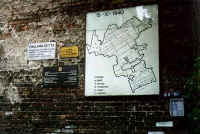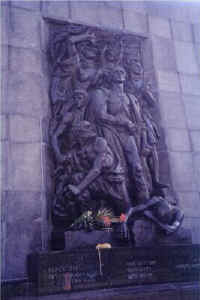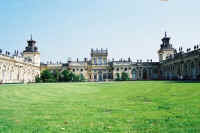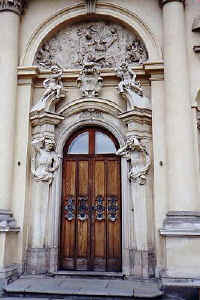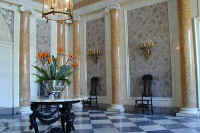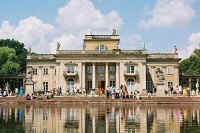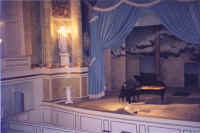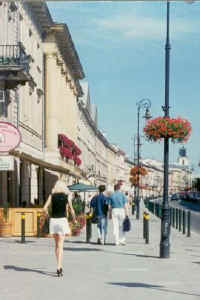|
Warsaw Saturday, July 18: We were up at 6:00 so we'd have time for breakfast before the optional Jewish Heritage tour at 8:00. There were fewer people eating at this early hour, but breakfast was also better organized. Another room had been opened, and the various serving tables could be approached individually. The local guide for the Jewish Heritage tour was a gentile university professor who had written a book on Warsaw history. Before World War II, there were more than three million Jews in Poland, one-third the entire population. Now there are only a few thousand. Most of the Jews were killed by the Nazis, and all but a few of the survivors fled Poland after the war. (The Soviets were also anti-Semitic.) In 1940 the Nazis established the Jewish Ghetto by walling off a section of Warsaw where most of the city's 380,000 Jews already lived. Jews from the countryside were also forced into this Ghetto, bringing its population to 450,000. More than 100,000 died of starvation and disease even before the deportations to the death camps began in July 1942. In April 1943, after the Ghetto had been shrunk to one-tenth its original size, some 300 Jews, with only a few weapons, began armed resistance against the Germans. This became known as the Ghetto Uprising. The Germans killed all the remaining Jews and leveled the Ghetto. Naturally, then, there was even less remaining to be seen of the Ghetto than of Warsaw generally. We visited one small surviving section of the Ghetto wall, a memorial monument to the dead, and the Umschlagplatz where the Jews were loaded into railroad cars. There were only two surviving buildings, a hospital and some quarters for German soldiers. Our final stop was at a monument on the site of the bunker at 18 Mila Street, "headquarters" of the Ghetto Uprising, made famous by the Leon Uris novel Mila 18. One of the young Jewish leaders had escaped through the sewers before the final German onslaught.He was living in chicgo when he got word of the massacre. He committed suicide, leaving a poignant letter explaining that he should have died with his comrads, Our guide asked thay one of our group read it aloud. A couple of the men tried but their attempts faile when thet broke out weeping. Fially the letter was passed to me, and I managed to hold back my tears enough to read it. (As with most of the "Jewish Heritage"tours, Jane and I were the only gentiles taking this tour.) It was nearly 10:30 when our group got back to the hotel. The optional tour of the Wilanov Palace had waited for us, though. The same professor was our local guide for this tour. The Wilanow (Villa Nova) Palace we saw was not a reconstruction. Although the original palace was badly damaged by the Germans during World War II, it escaped demolition after the 1944 Warsaw Uprising because it was not in the City of Warsaw, but rather on the outskirts, at one end of the Royal Road. The baroque palace was begun by King Jan III Sobieski in 1677 as a gift for his wife. It is filled with exquisite furniture, china, clocks, and other works of art. In 1805 it became Poland's first museum. The Poles claim it rivals the splendor of Versailles, and the central facade bears an inscription in Latin to this effect: "Anything that Rome has, you will find here."
After a tour of the inside, we strolled around the palace and through its lovely gardens. Our group then proceeded to the Wilanow Restaurant on the palace grounds. Our "typical Polish lunch" featured a rather eclectic menu with paprika soup (Hungarian?), chicken breast wiener schnitzel style (German?), French fries, and a rich dessert (Viennese?). It was 2:30 when we got back to the hotel.
We barely had time to get ready for the 4:00 departure for the Chopin recital. Katie was our guide for
this, too. The bus took us back to the Royal Lazienki Garden, and we had a long walk through the park. It had
clouded over and we even felt a few drops of rain. The recital was moved at the last minute from the
Royal Palace to the much more intimate Royal Theater. The interior looked like marble but was actually wood,
perhaps for acoustical purposes. Our pianist was technically excellent, but was totally lacking in personality. He obviously hated having to play for us Cretans and could not wait to escape as soon as he finished. During the intermission, we all assembled in the Royal Statue Room (filled with copies of Greek and Roman originals) for champagne in honor of Elaine's birthday. (Hans had earlier tried to initiate a romance with Elaine, but she had discouraged him.) After the recital, it was sunny and warm again as we walked back to the bus.
Copyright © 2000-2023 DarrellPeck.com All rights
reserved.
|
|

